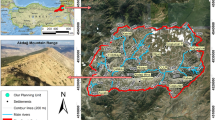Abstract
An investigation of the performance of biological erosion control measures applied to support pastoral land use in soft rock hill country has yielded information which can be applied in the design of more sustainable, silvopastoral land uses. Vegetation-based treatments, centred particularly on use of fast-growing poplars and willows, have successfully controlled a range of gully erosion and earthflow mass movement problems. Treatments were found to be successful at 63% of earthflow sites, and 42% of gully erosion sites examined, using an evaluation technique known to be conservative. A total of 278 sites were included in the study. Relationships between performance and site and treatment attributes allowed minimum tree configurations to be specified in terms of tree spacing and coverage of erosion landforms. Although further data collection would allow refinement of these minimum specifications, the need for such data depends on the value of tree crop versus pastoral production.
Similar content being viewed by others
References
Biddle PG (1983) Patterns of soil drying and moisture deficit in the vicinity of trees on clay soils. Geotechnique 33:107–126
Eyles GO (1983) The distribution and severity of present soil erosion in New Zealand. N.Z. Geographer 39 (1):12–28
Gage M and Black RD (1979) Slope stability and geological investigations at Mangatu State Forest. Forest Research Institute Technical Paper 66, N.Z. Forest Service
Gray DH and Megahan WF (1981) Forest vegetation removal and slope stability in the Idaho batholith. USDA Research Paper INT-271, 23 pp
Gray DH and Leiser AT (1982) Biotechnical Slope Protection and Erosion Control. Van Nostrand Reinhold, New York, 271 pp
Hessell JWD (1980) The climate and weather of the Gisborne region. N.Z. Met. Service Misc. Publ. 115 (8), 29 pp
Keefer DK and Johnson AM (1983) Earth flows: morphology, mobilization and movement. U.S. Geol. Survey Prof. Paper 1264, 56 pp
Luckman PG and Thompson RC (1993) Multi-attribute monitoring of impacts of erosion control in steeplands. ITC Journal (in press)
New Zealand Meteorological Service (1985) Annual rainfall. Climatic Map Series, Part 6, N.Z. Met. Service Misc. Publication 175
O'Loughlin CL (1984) Effectiveness of introduced forest vegetation for protection against landslides and erosion in New Zealand's steeplands. In: O'Loughlin CL and Pearce AJ, Symposium on Effects of Forest Land Use on Erosion and Slope Stability, pp 275–280. East-West Centre, University of Hawaii
Pearce AJ and Hamilton LS (1986) Water and soil conservation guidelines for land-use planning. East-West Centre, University of Hawaii
Peace AJ, O'Loughlin CL, Jackson RJ and Zhang XB (1987) Reforestation: on-site effects on hydrology and erosion, eastern Raukumara Range, New Zealand. In: Forest Hydrology and Watershed Management, pp 489–497. Proc. Vancouver Symposium, IAHS-AISH Publ. Nr 167
Richards BG, Peter P and Emerson WW (1983) The effects of vegetation on the swelling and shrinking of soils in Australia. Geotechnique (33):127–137
Sidle RC, Pearce AJ and O'Loughlin CJ (1985) Hillslope Stability and Land Use. A.G.U. Water Resources Monograph 11, American Geophysical Union, 140 pp
Soil Survey Staff (1975) Soil Taxonomy: A Basic System of Soil Classification for Making and Interpreting Soil Surveys. USDA Soil Conservation Service, Agriculture Handbook 436, 754 pp
Trotter CM, Pinkney EJ and Tod HG (1992) Weathering and strength loss at an earth-flow site. Proc. 6th Int. Symposium on Landslides, Christchurch
Trustrum NA and Hawley JG (1986) Conversion of forest land use to grazing: a New Zealand perspective on the effects of landslide erosion on hill country productivity. FAO RAPA Report 1986/3, pp 73–93
Van Kraayenoord CWS and Hathaway RL (1986) Plant Materials Handbook for Soil Conservation, Vol 1. Principles and Practices. Water and Soil Miscellaneous Publ. 93. Ministry of Works and Development, New Zealand, 295 pp
Varnes DJ (1978) Slope movement types and processes. In: Landslides, Analysis and Control. Transportation Research Board. Nat. Acad. Sci. Special Rep. (176):11–33
Young A (1989) Agroforestry for Soil Conservation, C.A.B. International, 276 pp
Ziemer RR (1981) Roots and the stability of forested slopes. IAHS-AISH Publ. 132: 342–357
Author information
Authors and Affiliations
Rights and permissions
About this article
Cite this article
Thompson, R.C., Luckman, P.G. Performance of biological erosion control in New Zealand soft rock hill terrain. Agroforest Syst 21, 191–211 (1993). https://doi.org/10.1007/BF00705230
Issue Date:
DOI: https://doi.org/10.1007/BF00705230




